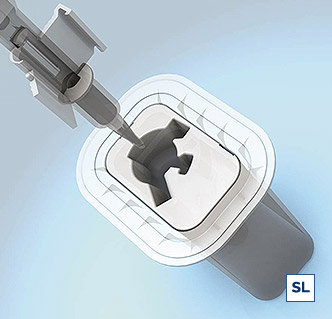ASPIRA-aA/-aAY
Monofocal premium IOL
for optimal cataract treatment
The ASPIRA-aA/-aAY is a one-piece monofocal capsular bag lens with all the advantages of a premium IOL:
Overview of topics
Monofocal
ASPIRA-aA
Monofocal
ASPIRA-aAY YELLOW
Personal
Contact
| Type | Monofocal posterior chamber IOL, 1-piece, foldable, optional blue light protection |
| Optic diameter | 6.0 mm |
| Total diameter | 12.5 mm |
| Material | Hydrophilic, glistening-free acrylic, UV absorber |
| Optic features | Aspheric anterior surface, aberration-free, 360° LEC barrier |
| Haptic design | C-loop |
| Constants for IOL calculation | Please click here |
| XL diopter range | -20.0 to 60.0 D in 1.0 D steps 10.0 to 30.0 D in 0.5 D steps Also preloaded in SAFELOADER®: diopter range may differ |
| eIFU | Please click here: ASPIRA-aA/-aAY Please click here: SAFELOADER® |
| Injector system | Please click here |
Preloaded implantation system
SIMPLE. INTUITIVE. FAST.
SAFELOADER®
More about ASPIRA-aA/-aAY
Excellent imaging quality
Exceptional delivery range
Aberration-free – suitable for all patients
Spherical aberration (SA) is a higher-order imaging error that can affect the contrast vision of patients after IOL implantation. Aberration-correcting IOLs are based on average values of corneal SA measurements. However, these IOLs can only partially compensate or even amplify the patient specific SA, since it varies greatly within individuals.
The aberration-free optic of the ASPIRA-aA/-aAY offers the basis for excellent imaging quality. The aspheric optic design is aberration-neutral, so that no additional imaging error is introduced into the eye. It is suitable for all patients, regardless of corneal aberration. Compared with spherical or aberration-correcting IOLs, patients benefit from increased contrast sensitivity and depth of field.
XL diopter range
The ASPIRA-aA/-aAY is available in an exceptionally wide delivery range beyond standard values commonly available on the market. IOLs with a sphere of -20.0 to 60.0 D provide optimal treatment, even for patients with extreme visual defects.
Premium IOL ASPIRA-aA/-aAY
Your advantages of the premium IOL platform
Preloaded implantation system
SAFELOADER®
SIMPLE. INTUITIVE. FAST.
Separate components for maximum safety
The contactless preloaded implantation system offers a maximum of safety due to separation of the components. Both the IOL and the injector undergo separate sterilization processes. The isolated storage of the IOL ensures that it only comes into contact with the coating additives of the cartridge immediately prior to the surgery.
Easy to use: maximum flexibility
Another strength of the SAFELOADER® lies in its uncomplicated usage. The two-component autoloading system offers individual flexibility in the OR: combine the premium IOL of your choice with the desired incision size of the respective injector for minimally invasive implants (MICS).
Application
Publications
Reports from clinical application
ASPIRA-aA/-aAY
Walz A, Kustra A, Rozegnal-Madehj A., et al.
Intraocular lens power calculations in eyes with pseudoexfoliation syndrome
Sci Rep 2021 Sep 24; 11(1):19071
Click here for full report
Naujokaitis T, Scharf D, Baur I, Khoramnia R, Auffarth GU
Bilateral implantation of +56 and +58 diopter custom-made intraocular lenses in patient with extreme nanophthalmos
Am J Ophthalmol Case Rep. 2020 Oct 9
Click here for full report
Mayer CS, Hyeck-Soo S, Grzegorz L, et al.
In vitro optical quality assessment of a monofocal intraocular lens sutured to an artificial iris
J Cataract Refract Surg 2020 Jun; Epub ahead of print
Click here for full report
Schrecker J, Langenbucher A, Seitz B, et al.
First results with a new intraocular lens design for the individual correction of spherical aberration
J Cataract Refract Surg 2018 Aug 14; Epub ahead of print
Click here for full report
Lasta M, Mihálth K, Kovács I, et al.
Effect of Spherical Aberration on the Optical Quality after Implantation of Two Different Aspherical Intraocular Lenses
J Ophthalmol. 2017;2017:8039719
Click here for full report
Küchle M
Comparison of visual function with aspheric yellow, aspheric clear and spherical clear intraocular lens
J Emmetropia 2013 Jul; 4:123-130
Click here for full report
Eppig T, Scholz K, Löffler A, et al.
Effect of decentration and tilt on the image quality of aspheric intraocular lens designs in a model eye
J Cataract Refract Surg 2009 Jun; 35:1091-1100
Click here for full report
This post is also available in: German
OUR
CUSTOMER SERVICE
YOUR
QUESTIONS
Our experts support you with your questions at any time.






